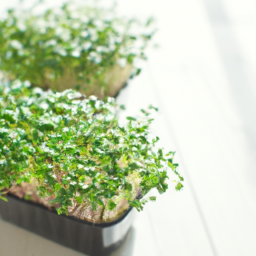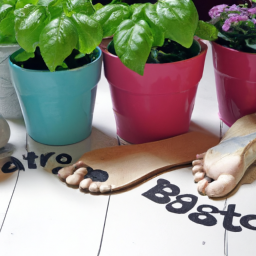
Are you looking for a sustainable source of fresh greens that you can grow right in your own home? Look no further than growing edible microgreens indoors! These tiny, nutrient-packed plants are not only easy to grow, but they also provide a continuous supply of delicious and nutritious greens for your meals. In this blog post, we will explore the benefits of growing edible microgreens indoors and provide you with tips and tricks to help you get started on your own indoor microgreen garden. So, grab your gardening gloves and let’s get growing!
Benefits of Growing Edible Microgreens Indoors
Introduction
When it comes to fresh and nutritious greens, edible microgreens are a fantastic option that you can easily grow indoors. These tiny greens are packed with flavor and nutrients, making them a great addition to salads, sandwiches, and even smoothies. In this guide, we will explore the benefits of growing edible microgreens indoors and provide you with a step-by-step guide on how to do so.
Health Benefits
One of the main benefits of growing edible microgreens indoors is the health benefits they offer. These tiny greens are packed with vitamins, minerals, and antioxidants that are essential for overall health and well-being. Studies have shown that microgreens contain higher concentrations of nutrients compared to their mature counterparts, making them a superfood in their own right.
By growing your own microgreens indoors, you can ensure that they are free from harmful pesticides and chemicals. You have full control over the growing process, allowing you to harvest fresh and organic greens whenever you need them. Incorporating microgreens into your diet can help boost your immune system, improve digestion, and promote healthy skin and hair.
Furthermore, growing your own microgreens can be a cost-effective way to add fresh greens to your meals. Instead of buying expensive packaged microgreens from the store, you can grow your own at a fraction of the cost. All you need is a small space indoors, some seeds, and a little bit of time and effort.
In addition to the health benefits, growing edible microgreens indoors can also be a sustainable practice. You can reduce your carbon footprint by growing your own greens at home, eliminating the need for transportation and packaging. By using organic and eco-friendly growing methods, you can contribute to a healthier planet while enjoying fresh and nutritious greens.
How to Grow Edible Microgreens Indoors
Now that you understand the benefits of growing edible microgreens indoors, let’s dive into the step-by-step process of how to do so. First, you will need to gather the necessary materials, including seeds, a growing tray, soil, and water. Choose a sunny spot in your home where your microgreens can receive adequate sunlight.
Next, fill your growing tray with a thin layer of soil and sprinkle the seeds evenly across the surface. Gently press the seeds into the soil and mist them with water to keep them moist. Cover the tray with a clear lid or plastic wrap to create a greenhouse effect, which will help the seeds germinate faster.
Over the next few days, make sure to water your microgreens regularly and keep them in a sunny spot. As they begin to grow, you can remove the cover and allow them to receive direct sunlight. In about 1-2 weeks, your microgreens will be ready to harvest. Simply cut them with scissors just above the soil line and enjoy them fresh in your favorite dishes.
In conclusion, growing edible microgreens indoors is a sustainable and rewarding practice that offers a wide range of health benefits. By following the simple steps outlined in this guide, you can enjoy fresh and nutritious greens year-round, right from the comfort of your own home. So why not give it a try and start growing your own microgreens today?

Tips for Successfully Growing Microgreens at Home
Introduction
Microgreens are young vegetable greens that are harvested just after the first leaves have developed. They are not only delicious but also packed with nutrients, making them a popular choice for health-conscious individuals. Growing microgreens at home is a sustainable way to have a fresh supply of greens right at your fingertips. In this guide, we will provide you with tips on how to successfully grow microgreens indoors.
Choosing the Right Seeds
When it comes to growing microgreens, choosing the right seeds is crucial. Opt for organic, non-GMO seeds that are specifically labeled for microgreen production. Some popular microgreen varieties include broccoli, radish, sunflower, and pea shoots. Make sure to purchase seeds from a reputable supplier to ensure quality and germination success.
Before planting, it is recommended to soak the seeds in water for a few hours to kickstart the germination process. This will help speed up the growth of your microgreens and ensure a bountiful harvest.
Additionally, consider experimenting with different seed combinations to create unique flavor profiles and textures in your microgreen harvest. Mix and match seeds to find your favorite combinations and add variety to your indoor garden.
Preparing the Growing Medium
The growing medium plays a crucial role in the success of your microgreen harvest. Opt for a high-quality, sterile seed starting mix that is lightweight and well-draining. Fill a shallow tray or container with the growing medium, leaving about an inch of space at the top for the seeds to germinate.
Before planting the seeds, moisten the growing medium thoroughly to ensure proper hydration for germination. Avoid overwatering, as this can lead to mold and fungal growth. Place the tray in a sunny spot with indirect sunlight or under grow lights to provide the necessary light for the seeds to sprout.
Throughout the growing process, monitor the moisture levels of the growing medium and water as needed. Keep the soil consistently moist but not waterlogged to promote healthy growth and prevent root rot.
Caring for Your Microgreens
Once your microgreens have sprouted, it is important to provide them with proper care to ensure a successful harvest. Rotate the tray daily to promote even growth and prevent leggy stems. Thin out any overcrowded seedlings to allow room for proper development.
Continue to monitor the moisture levels of the growing medium and water as needed. As the microgreens grow, they will require more water to support their rapid growth. Avoid using chemical fertilizers and opt for organic options to feed your microgreens and promote healthy, nutrient-rich greens.
Harvest your microgreens when they have reached the desired size, typically around 1-2 inches tall. Use clean scissors to snip the greens just above the soil line, leaving the roots intact. Enjoy your fresh, homegrown microgreens in salads, sandwiches, smoothies, and more!

Sustainable Practices for Indoor Microgreen Cultivation
Choosing the Right Containers
When it comes to growing edible microgreens indoors, choosing the right containers is essential for sustainability. Opt for containers made from recycled materials or ones that can be easily recycled after use. Avoid using plastic containers that can leach harmful chemicals into the soil and ultimately your microgreens. Instead, consider using biodegradable pots made from materials like coconut coir or bamboo.
Another sustainable option is to repurpose containers you already have at home, such as old yogurt containers or egg cartons. Just make sure to poke holes in the bottom for drainage. By choosing environmentally-friendly containers, you can reduce your carbon footprint and contribute to a more sustainable indoor microgreen cultivation practice.
Additionally, consider investing in self-watering containers that can help conserve water and reduce waste. These containers have built-in reservoirs that allow the plants to absorb water as needed, reducing the risk of overwatering and water runoff. By choosing the right containers, you can create a more sustainable and eco-friendly indoor microgreen growing setup.
Using Organic Soil and Fertilizers
Organic soil and fertilizers are key components of sustainable indoor microgreen cultivation. Opt for organic potting soil that is free from synthetic chemicals and pesticides, as these can harm the environment and your health. Look for soil that is rich in nutrients and promotes healthy plant growth without the use of harmful additives.
When it comes to fertilizing your microgreens, choose organic options like compost or worm castings. These natural fertilizers provide essential nutrients to your plants without the use of synthetic chemicals. Avoid chemical fertilizers that can leach into the soil and harm beneficial microorganisms. By using organic soil and fertilizers, you can ensure a sustainable and eco-friendly indoor microgreen growing practice.
Consider starting a compost bin to create your own organic fertilizer from kitchen scraps and yard waste. Composting not only reduces waste but also provides nutrient-rich soil for your microgreens. By using organic soil and fertilizers, you can promote healthy plant growth while minimizing your environmental impact.
Implementing Energy-Efficient Lighting
Energy-efficient lighting is crucial for sustainable indoor microgreen cultivation. Opt for LED grow lights that consume less energy and produce less heat compared to traditional lighting options. LED grow lights are also long-lasting, reducing the need for frequent replacements and lowering your energy consumption.
Position your LED grow lights strategically to provide optimal light exposure to your microgreens. Consider using timers to regulate the lighting schedule and ensure that your plants receive consistent light cycles. By implementing energy-efficient lighting, you can reduce your carbon footprint and create a more sustainable indoor microgreen growing environment.
Additionally, consider utilizing natural light whenever possible to supplement your artificial lighting. Place your microgreens near a sunny window or under a skylight to take advantage of natural sunlight. By combining natural and artificial lighting sources, you can create a more sustainable indoor microgreen cultivation setup that promotes healthy plant growth.
Let’s bring it all home
Have you ever wanted to grow your own fresh greens at home, but didn’t have the space or resources for a full garden? Well, look no further than edible microgreens! These tiny, nutrient-packed greens are not only easy to grow indoors, but they also provide a sustainable source of fresh produce right at your fingertips.
Microgreens are essentially young vegetable or herb greens that are harvested when they are just a few inches tall. They are rich in vitamins, minerals, and antioxidants, making them a healthy addition to any meal. Plus, they are incredibly easy to grow indoors with just a few simple supplies like seeds, soil, and water. By growing your own microgreens at home, you can reduce your carbon footprint by cutting down on transportation costs and packaging waste associated with store-bought greens. So why not give it a try and start enjoying the benefits of fresh, sustainable microgreens right in your own kitchen?
FAQ Roundup:
Q1: What are microgreens?
Microgreens are young vegetable greens that are harvested just after the first leaves have developed. They are packed with nutrients and flavor, making them a popular choice for adding a fresh and healthy touch to dishes.
Q2: Why grow microgreens indoors?
Growing microgreens indoors allows you to have a sustainable source of fresh greens year-round, regardless of the season. It also gives you control over the growing conditions, ensuring that your microgreens are free from pesticides and other chemicals.
Q3: How do I grow edible microgreens indoors?
To grow edible microgreens indoors, you will need a shallow container, potting mix, seeds, and a sunny windowsill or grow light. Simply plant the seeds in the container, water them regularly, and watch them grow into delicious and nutritious microgreens.
Q4: What are some popular edible microgreens to grow indoors?
Some popular edible microgreens to grow indoors include broccoli, radish, kale, and sunflower. These varieties are easy to grow and add a burst of flavor and color to salads, sandwiches, and other dishes.
Q5: How long does it take to grow microgreens indoors?
Microgreens typically take 1-2 weeks to grow indoors, depending on the variety. Once they have developed their first true leaves, they are ready to be harvested and enjoyed.

Alex Turner is a sustainable gardening advocate and the founder of an acclaimed indoor gardening blog. With a focus on eco-friendly practices and urban sustainability, Alex combines his background in environmental studies with his love for plants to educate readers on mindful indoor gardening. His work highlights the importance of nurturing both plants and the planet.


